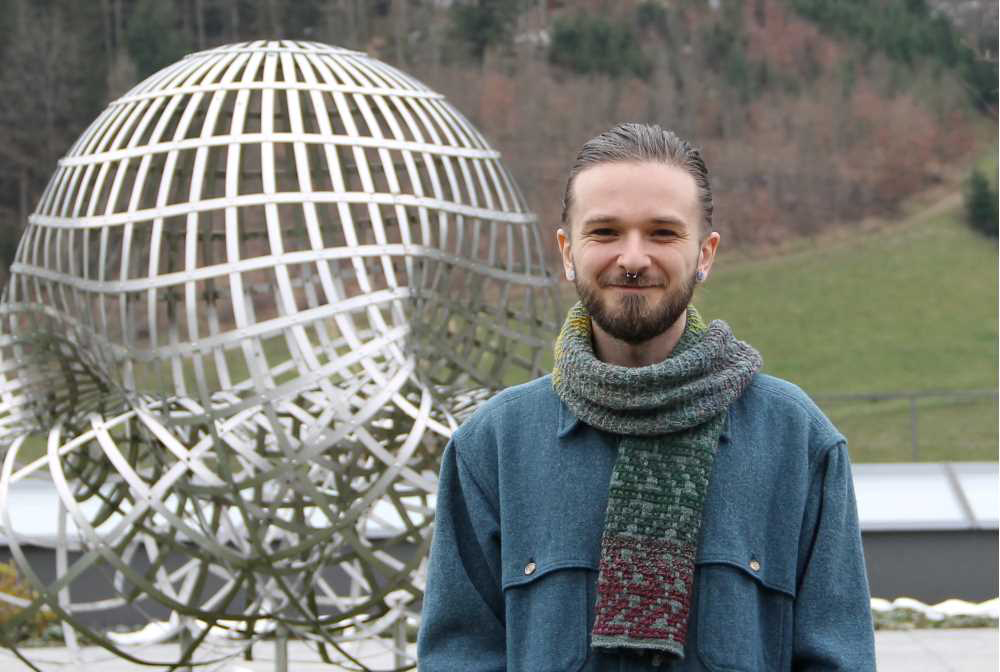
Isaac Sundberg, a postdoctoral fellow at the Max Planck Institute for Mathematics in Germany, graduated from UWL in 2016 with a major in mathematics and a minor in computer science. Sundberg studies low-dimensional topology with a focus on 4D knot theory. Photo courtesy of Archives of the Mathematisches Forschungsinstitut Oberwolfach.
For 40 years, mathematicians around the world grappled with a challenging problem in knot theory. Today, that problem has been solved, thanks to the groundbreaking work of Isaac Sundberg, a 2016 graduate of UW-La Crosse’s mathematics program.
Sundberg, now a post-doctoral fellow at the Max Planck Institute for Mathematics in Germany, has made significant strides in knot theory, a branch of mathematics within topology. Their recent research, which has garnered attention from esteemed math and science publications like Quanta Magazine and AMS: Math in the Media, identifies a pair of Seifert surfaces that retain distinct differences even when projected into the fourth dimension.
“For decades, mathematicians debated whether certain Seifert surfaces, which exhibit three-dimensional differences, would preserve those differences when extended to 4D,” Sundberg explains. “I never anticipated solving it in my lifetime. When it happened, the problem consumed my thoughts. I couldn’t sleep.”
The breakthrough emerged from Sundberg’s use of Khovanov Homology, a modern tool in mathematics. “It has been a question of mine how far can we push this tool to discover new 4D phenomena,” says Sundberg.
Piano prelude
Sundberg’s journey into mathematics began unexpectedly. Originally a piano student at UWL, they shifted focus to mathematics after a series of academic pivots, including studies in physics and computer science.

Tushar Das, UWL professor of Mathematics & Statistics, recalls first meeting Sundberg at the La Crosse People’s Food Co-op. The two talked about their common love for playing piano.
“I had played since I was a child and had very similar plans at around Isaac’s age, my mother being a piano teacher in Calcutta was a great boon. So I gently suggested to Isaac that I was confident that he would find mathematics at least as beautiful, challenging, and creative as I did, and that he should take some math classes to confirm my suspicions,” says Das.
Sundberg’s interest in topology was sparked by a special topics class organized by UWL Professors Whitney George and Das pro-bono after several students expressed interest. This introduced them to the field’s unique approach to geometric problems.
The class would meet once or twice a week in seminar format, and the group would work through textbook problems together. Unlike a typical math lecture where a faculty member leads the discussion, here the math students presented the problems they were learning and where they were struggling to the professors.
“It was amazing because that is how math research works,” says Sundberg. “It gave me a taste of how to dig into something on my own and explain it to someone else.”
Often other faculty and students would join the seminars, which led to enhanced curiosity, engagement, and confidence throughout, says Das. These seminar classes eventually led to George and Das creating a brand new MTH 415 Topology course that is now offered each spring semester.
This exposure to topology led Sundberg to develop a deep passion for the field that often involves visualizing complex problems rather than relying on numerical calculations. As a UWL student, Sundberg would take a walk through the woods or draw a picture to work out a particular problem. “I got hooked on doing these problems in my head, and it grew into a passion of mine,” says Sundberg.
During their undergraduate years, Sundberg collaborated with Robert Allen, UWL’s interim associate dean of the College of Science and Health, on Sundberg’s first published mathematics paper.
“Robert was an amazing, supportive role model,” says Sundberg. “I learned about the whole process of mathematics research — coming up with questions, trying to solve them, developing proofs others can read, and turning that into a document that can be published.”
Inspired by UWL faculty members such as Allen, George, Das, Eddie Kim, and former faculty member Ted Wendt, Sundberg sought to emulate their support and teaching excellence. This led Sundberg to graduate school in mathematics and eventually a post-doctoral fellowship at the Max Planck Institute, one of the world’s premier mathematics research institutions. They also maintain a part-time teaching position at the University of Bonn.
Sundberg’s recent achievement in solving the knot theory problem was a moment of fulfillment. “It was surreal to solve a problem I had dreamed about for so long,” they reflect.
The collaborative effort, which included contributions from friend and colleague Maggie Miller, resulted in a significant paper that addresses the longstanding mathematical question.
In July, Sundberg returned to the U.S. for a visit, reconnecting with family, friends, and UWL faculty. “The Mathematics Department at UWL provided incredible support throughout my journey,” says Sundberg. “They encouraged me through failures and successes alike. They are role models who support you throughout your career. I wouldn’t be here without them.”
What is topology?
Knot theory, within the branch of mathematics called Topology, was something Sundberg had never heard of until studying mathematics as an undergraduate at UW-La Crosse. Not the typical math of numbers and equations, topology is the study of geometric objects and how their properties are preserved through deformations, such as stretching, twisting, and bending.
Learn more about UWL Mathematics & Statistics.
Written by UW-La Crosse
Link to original story: https://www.uwlax.edu/news/posts/from-piano-to-proofs/
